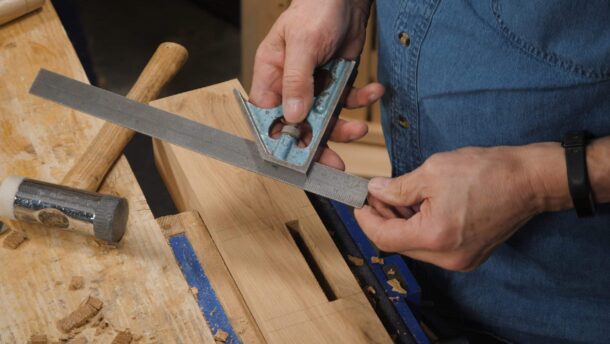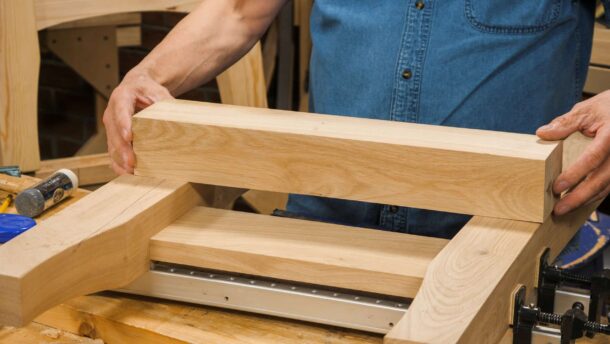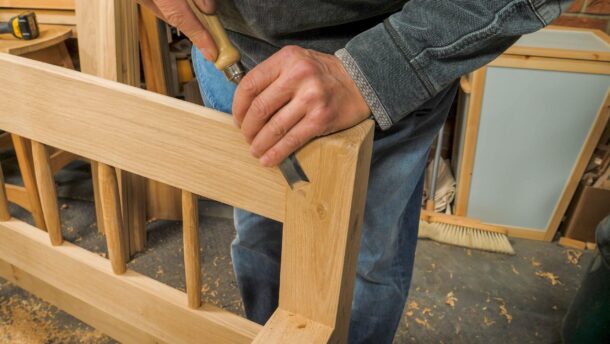Garden Bench
Posted 4 April 2019
This is the introductory page for a paid video series. Want to watch more of this project? Select the best option below to get started.
With the garden looking decidedly bright and beautiful, Paul brings us this perfectly formed Garden Bench. The use of drawbore joinery means that no glue is used in this project. On the aesthetic side, it showcases those subtle touches that Paul is so adept at using to bring a piece together and elevate it above the merely functional. It’s also very comfy.







Looks amazingly beautiful.
I was looking forward to this one. Looks really nice Paul, I think I’ll build along, I’m in need of a garden bench!
You are an amazing man Paul Sellers.it looks wonderful.really looking forward to this one
Paul, you’re videos encourage us to all slow down and enjoy what’s around us. Can’t wait for the episodes!
*your* – maybe I need to slow down just a little bit more…
Thank you Paul Ashton 🙂
Now nice and, in my locale, season appropriate!
That’s “How Nice” of course.
D’OH!
This will look beautiful in the bird and butterfly garden I plan to create this summer. Can’t wait to get started.
This is looking like a great project to take on, and great timing too, Paul!
A garden bench is something I have wanted to build for a long time. I will feel very comfortable in the build with your expert guidance, plan and instructions. My biggest hurdle is finding suitable wood locally, and I do hope that you discuss wood species that would be proper for the job. Thanks Paul.
Love the look of this bench and would like to build along. I would second the discussion of wood species. Can you talk about what would be good choices in a range of places around the world. Oak and teak are not readily available in Australia.
Thanks Paul
I agree I always have trouble sourcing good timber at a reasonable price
Anticipation! 🙂
Got mine started. I love this project.
Who’s ready to mortise, mortise, mortise?? Looks wonderful, can’t wait.
Can you comment on wood selection? Is that white oak that you are working with? That may be one of the more affordable woods that is suitable for outdoor use. What other woods would you recommend for a bench that will be located outside that won’t break the bank?
Hi Andrew,
I passed your question on to Paul and below is his answer:
The problem is that most of them will break the bank. As soon as they have durability strengths, the price seems to double.
Kind Regards,
Izzy
I plan to make this with cedar decking from home depot. About 3 times cheaper than white oak in this part of the world (southern Ontario). It will withstand the elements well, but western red cedar we get here is very soft. Wonder whether drawbore joints in such soft wood will stay tight in the long run. Would hardwood pegs be preferred in this case?
Anything else to watch out for when using soft wood for this purpose? I previously made an outdoor table and bench from cedar decking and fence posts and some of the pieces twisted badly once outdoors. Especially those ripped into two from a 6″ deck board as would be required for the seat slats.
Hi Selva,
I passed your question on to Paul and he said:
I don’t really know how Western Red Cedar will work because as you say it is very soft, rather than using the drawbore method to pull up the joints, you can use clamps or cargo webs, to draw up the joints and then simply peg them with a half inch dowel and now use them to draw up the joint. As long as the wood is dry, down to 10% say, the joints should be fine.
I doubt whether this will move once combined with good joinery as the joinery will retain everything.
Kind Regards,
Izzy
Do you think Pine should be done the same and not use the draw bore technique? What about water resistant glues?
Hi Sandy,
Paul says:
Water resistant does not mean waterproof and waterproof glues may not cover every area of surface so that means you have the potential for rot because the glue itself can contain the moisture and prevent it from evaporating.
Kind Regards,
Izzy
Is it 6 seat slats including the wider front slat or 5 (=4 + 1 wide) as in the cutting list? Four slats plus a front one leaves a ~2″ gap for me. The prototype seems to have 5 + 1 slats as well.
Hi Selva,
Paul says:
Thanks for pointing this out, it has 5 and a wide front one. We will change this on the drawing.
Kind Regards,
Izzy
There is an incorrect dimension on page 3 of the technical drawing – it shows the dado on the rails as being 3 1/2″, the centre rail is only 2 1/2″.
Hi Paul,
Thank you for pointing this out, Paul has had a look and it’s the middle support that should be 3 1/2″ not 2 1/2″ so we will get that changed on the drawing.
Kind Regards,
Izzy
I have a question regarding finishes. For this build, there was no finish used? I’m working on this project for my parents yard. I wasn’t able to easily find the oak needed, so I researched and settled on mesquite which seems to have similar properties to white oak as far as hardness (even harder than white oak), and rot/insect resistance.
Mesquite works out great since it’s in abundance here in Texas and I wanted to use wood that was from the area. But before I put it in it’s new home I wanted to make sure what I need for any kind of finish or sealer. Is there any advice you can give me?
Thanks!
Hi,
Paul says:
Using a finish means that you must enter into a maintenance programme, every 3-4 years the bench will need a new application of finish, leaving it bare wood the likelihood is that it will last 20 years or longer with no treatment at all, that said the Mexicans used mesquite to make roads, doors and railways ties. I think you would be safe to say this is a rotten resistant wood.
Izzy
Hello,
I’m just making this bench for a friend and I wonder what is a fair price for such bench. The oak was abou GBP 300.
Thanks
Vlad
Vlad, if it was me I would start by looking on line for comparable pieces of furniture, to get an idea what the production pieces are going for. Then I would think about whether this is the first time you have tried something like this (so it will take more time, there may be some mistakes that you can’t fix or hide), whether you also have to buy any more tools on top of the cost of the wood or spend time practicing a new technique, and if you have committed to any specific delivery date that may force you to spend more time in the workshop than you would normally.
Then I would start thinking about the mid point between the material and tool costs and the production piece cost, and then see how you feel based on the way it all worked.
And if you can find some simple embellishments, or features that you can easily incorporate to make the bench even more unique, then add some more to the cost.
Hi,
Thank you for your comments and advice. As I was not doing the bench for profit I have just asked for the price of the oak which was £400. I have also told my friend/customer that it took me 77 hours to make and that I leave it to him how much he wants to pay me. And he paid me £1,250 which I was not expecting at all and I think it was more than a fair amount. Him and his wife were very pleased with it. I have made a video of the project and you can find it on youtube on my “TTvlade” channel if you are interested to see how it turned out. Anyway. Take care! And keep making! 😊
Vlad
Nice, well done. It’s always a good feeling when you get more than you were expecting. And I suspect that your friends also feel good with that price as well. I had a similar experience with a couple of custom doors that I made.
I don’t tend to keep track of the time I spend working on a project, unless it’s one I am not very enthusiastic about 🙂
Hej Vlad,
The bench you are making is priceless because it can’t be bought for money.
It cannot be found over the counter. If you weren’t making it, your friend would have to find another furniture maker, who would take it on as a unique bespoke project, and that would come at a very substantial charge. Add that the work is to be done with hand tools, and it might be next to impossible to find that furniture maker.
I video recorded the work behind a few of the items I’ve made. After watching those videos, customers (a most limited number) have been much more understanding of 4 figures; which wouldn’t be unfair should you ask some amount in that range. The drawbored joints alone are worth a fortune – particularly if you can replace the oak dowels with juniper ones.
Hi,
I have also shown them the video and it made them to appreciate the bench even more. It is a great feeling.
Vlad
I’ve often wondered how this project has aged if it has in fact been outside this whole time. If I remember correctly, somewhere along the way Paul made mention of testing the oak version vs the pine version in terms of dealing with the elements …. Or some comment related to that.
I’d love to see an update video not only on this project but many others.